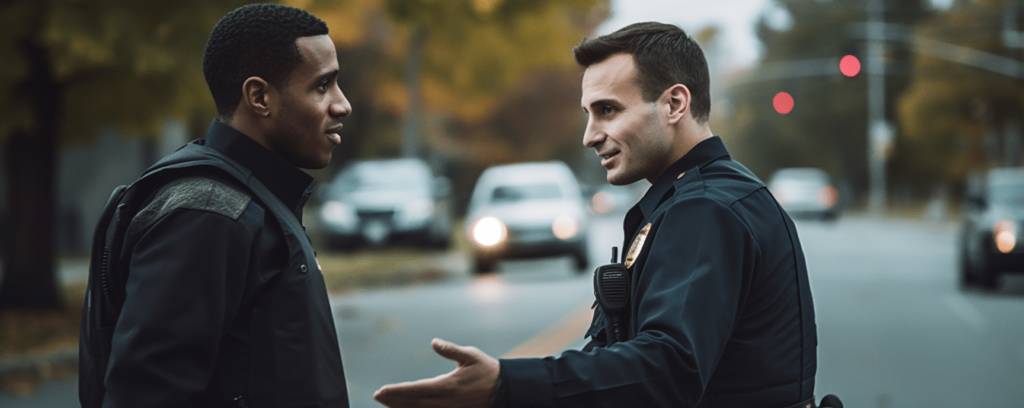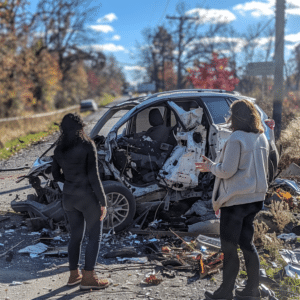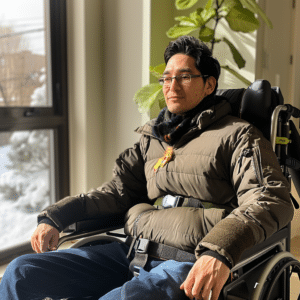Maximizing Your Claim: Car Accident Evidence to Gather Post-Collision
Last updated Wednesday, October 30th, 2024

Collecting the right car accident evidence is critical for any claim. This straightforward guide will show you the key pieces of evidence you need and explain their significance in determining fault and negotiating compensation.
Key Takeaways
- Immediately after a car accident, it is critical to document the scene with photographs, gather witness testimonies, and report to law enforcement to compile evidence that can determine liability and support claims.
- Establishing fault in a car accident incident is dependent on analyzing police reports, assessing adherence to or violations of traffic laws by parties involved, and reviewing damages and witness statements to create an objective narrative.
- Professional legal assistance from a car accident lawyer can provide invaluable support in collecting and presenting evidence, negotiating with insurance companies, and ensuring rightful compensation for both economic and non-economic damages.
Key Evidence to Collect Right After a Car Accident
Following a car accident, your initial focus should be on ensuring everyone is safe. With safety secured, your next step is to gather crucial evidence. This evidence forms the backbone of any car accident claim and can prove crucial in establishing fault and negotiating compensation.
Photographs taken at the scene can serve as vital physical evidence during the investigation. A clear and detailed visual record can help to:
- Reconstruct the events accurately
- Determine liability
- Provide a tangible record of the accident’s impact
- Show the position of the cars
- Document the condition of the surrounding area
It’s like freezing the accident scene in time, providing a valuable reference point for future investigations.
The significance of witness testimonies should not be underestimated. Witnesses provide an unbiased account of the accident, which can be invaluable in corroborating your version of events.
Finally, remember to report the accident to the police. A detailed police report can provide an authoritative account of the accident and play a significant role in determining fault.
Documenting the Scene with Photographs
In car accident cases, photographs can prove to be persuasive evidence. They provide a visual record of the accident scene, capturing details that might otherwise be overlooked or forgotten. These images can serve as a stark reminder of the severity of the crash, the damage caused, and any other relevant factors such as weather conditions or road obstructions.
Your approach to photographing the scene is also significant. It’s advisable to capture:
- Wide shots that give context to the accident
- Close-ups that highlight specific details
- Images with time and date stamps, along with location data, as they confirm the timing and location of the accident
All these elements contribute to a well-documented scene of the accident that can be invaluable in understanding the mechanics of how the accident happened and supporting your claim.
Gathering Witness Testimony
In car accident cases, witness testimonies can potentially alter the outcome. An independent witness provides an unbiased account of the events, which can corroborate your version of what happened. This type of evidence can often tip the scales in your favor, especially when the other party’s account of events differs from yours.
While collecting witness testimonies, remember to:
- Interact with witnesses respectfully while highlighting the importance of their account
- Collect their contact details so you can reach out to them for further information if needed
- Take detailed notes of their accounts, especially those highlighting what they observed before and during the accident. This includes the actions of the drivers, the conditions of the vehicles involved, and the state of the traffic conditions.
Exchange Information and Report to Law Enforcement

When you report the accident to law enforcement, you’re also required to exchange information with the other parties involved. This information includes:
- Names
- Addresses
- Driver’s license numbers
- Vehicle registration details
- Insurance details
Securing this information is vital for initiating an insurance claim and can provide a clear record of who was involved in the accident.
Establishing Fault Through Collected Evidence
After collecting your evidence, your subsequent move should be to apply it in determining who is at fault. This process involves:
- Analyzing the police reports
- Reviewing the traffic laws that were potentially violated
- Considering the witness statements received
- Examining the details of the damage to the vehicles involved.
Police reports provide an objective narrative of the accident, which can be critical in determining fault. Similarly, any violation of traffic laws by a driver can serve as direct evidence of negligence, strengthening your case. Witness statements and photographs can also help to substantiate your claims and provide a comprehensive picture of the events leading up to the accident.
Analyzing Police Reports for Evidence of Fault
In car accident cases, police reports frequently serve as a fundamental component. They provide a detailed account of the accident, including statements from drivers, passengers, and witnesses, as well as the responding officer’s observations and opinions on any violation of traffic laws.
These reports are of immense value to insurance adjusters, judges, and jurors, given their implications on fault determination. However, it’s important to remember that inaccuracies in police reports can be challenged. By cross-referencing the report with your own evidence, such as photographs and witness testimonies, you can ensure that the report accurately reflects the events of the accident.
The Role of Traffic Laws in Determining Fault
Designed to safeguard all road users, traffic laws can indicate negligence in a car accident case when violated. If a driver has violated a traffic law, such as:
- running a red light
- failing to give way
- speeding
- texting while driving
- driving under the influence
This can be used to establish fault.
In some cases, a traffic violation may be recorded in the police report, thereby strengthening your case. Even if a traffic ticket does not conclusively prove negligence, it is compelling evidence that can support your claim in court.
In some instances, criminal convictions for traffic infringements connected to the accident can further reinforce the argument that the other driver was negligent when the accident occurred.
Assessing Vehicle Damage to Understand the Crash
Insights into the dynamics of the crash can be gleaned from the damage inflicted on the vehicles involved in a car accident. The location and severity of the damage can indicate the point of impact, the direction of force, and the movements of the vehicles. For instance, frontal damage may suggest a head-on collision, while damage to the side could indicate a side-impact or “T-bone” collision. Assessing this damage, along with the damage to surrounding objects, can provide context and additional clues to understand the crash dynamics. However, it’s important to remember that vehicle damage alone cannot prove fault due to the multifactorial nature of car accidents.
Medical Documentation: Proving Your Physical Injuries
In case of injuries from a car accident, medical documentation is vital for verifying the extent of your injuries. Not only does it establish the occurrence and extent of the injuries, but it also helps to create a direct causal link to the accident, providing essential proof of the defendant’s negligence.
This section will delve into the importance of immediate medical attention and records, and the impact of serious injuries on claims.
Immediate Medical Attention and Records
Post a car accident, immediate medical attention is imperative not only for your health but also as crucial evidence for your claim. A delay in seeking medical attention can make it difficult to prove the severity of your injuries and their physiological impacts, which can affect the valuation of pain and suffering damages.
Keeping detailed records of all medical expenses, including medical bills, is essential to establish the conditions resulting from the accident and the necessity of ongoing therapy or rehabilitation. These records should include:
- Ambulance and paramedic records
- Diagnostic testing records
- Records from all follow-up appointments
- Imaging studies such as X-rays, MRIs, and CT scans
Impact of Serious Injuries on Claims
Thorough documentation of serious injuries needing long-term care and rehabilitation, like broken bones or spinal cord injuries, is necessary to establish the need for prolonged compensation. Rehabilitation records and prescription records are essential to detail the extent of treatment and progress, thereby impacting the compensation received for serious injuries.
Proper documentation is critical in ruling out the argument that injuries sustained are due to an underlying condition rather than the accident itself. This is where a detailed treatment journal, including notes from visits to various medical professionals, can prove invaluable in supporting full reimbursement from insurance.
Financial Losses: Evidence of Economic Damages
A car accident’s financial impact goes beyond just immediate medical and repair costs. Lost wages due to time off work and the potential for decreased earning capacity can significantly affect your financial stability.
This section will delve deeper into how these financial losses are calculated and the evidence required to substantiate these claims.
Calculating Lost Wages Due to Accident
In a car accident claim, lost wages constitute a considerable part of the economic damages. To calculate lost wages, you need to multiply your daily wage by the number of workdays missed due to the accident. However, it’s important to note that lost wages claims can include not just base salary but also:
- commissions
- tips
- bonuses
- contributions to pensions and 401(k) plans.
For those who are self-employed or work on a commission basis, calculating lost wages can be a bit more complex. In such cases, involving expert witnesses may be needed to accurately forecast expected wage recovery. Other factors, such as forced retirement due to injury or job changes resulting in lower wages, should also be taken into account.
Estimating Repair Costs and Property Damage
Vehicle and other personal property damage is often the most conspicuous result of a car accident. To ensure that these repair costs are accurately estimated, it’s crucial to obtain repair estimates from licensed and registered auto shops.
Some insurance companies might send an adjuster to participate in the vehicle inspection and assist in generating a proper repair cost estimate. The insurance company may cover the cost of repairs by either issuing a check for the amount of the repair estimate or by paying the repair shop directly. Understanding this process can help you navigate it more efficiently and ensure you receive fair compensation for your property damage.
Non-Economic Damages: Quantifying Pain and Suffering

- physical pain
- emotional distress
- mental anguish
- loss of quality of life following a car accident
There are typically two methods used to calculate these types of damages: the multiplier method and the per diem method. The multiplier method involves adding up actual damages and multiplying the total by a number that represents the severity of the pain and suffering. The per diem method assigns a dollar value to each day of suffering.
Keeping a personal injury journal is recommended to document symptoms, pain levels, and the impact of injuries on daily life, which can serve as valuable evidence in a personal injury lawsuit.
Working with a Car Accident Lawyer
Dealing with a car accident claim’s complexities can be overwhelming, particularly when grappling with the accident’s physical and emotional repercussions. This is where the experience of a car accident lawyer at Isaacs & Isaacs can prove invaluable.
A lawyer can guide you through the insurance claim process, negotiate with insurance companies on your behalf, and ensure that your rights are protected.
The Importance of Legal Experience in Car Accident Cases
For maneuvering through the intricacies of the claims process and securing fair compensation in car accident cases, legal representation is indispensable. An experienced car accident lawyer can:
- Uncover additional sources of insurance
- Negotiate with insurance companies for higher payouts
- Communicate effectively with insurers and medical providers to maximize the portion of the settlement retained by you
Moreover, an attorney at Isaacs & Isaacs can address complex issues such as the calculation of lost wages for self-employed individuals or understanding your legal entitlements if you’re unable to work due to disability. Early involvement of a lawyer can also be critical in preserving key evidence and advocating for a higher value of the claim.
How Attorneys Assist in Collecting and Presenting Evidence
In car accident cases, attorneys have a pivotal role in gathering and presenting evidence. They can:
- Utilize the contact information collected by law enforcement
- Challenge inaccuracies in police reports
- Interview witnesses to compile strong evidence for your case
- Work to protect clients from making statements that might damage their claim
- Ensure an effective presentation of evidence to support their case.
They actively investigate cases from the outset, influencing initial claim valuations to prevent insufficient settlement offers from insurance companies. Moreover, the attorneys at Isaacs & Isaacs can aid in crafting a victim impact statement, giving a voice to your personal experience of pain and suffering.
Frequently Asked Questions
What evidence is commonly found at hit-and-run scenes?
Common evidence found at hit-and-run scenes includes eyewitness statements, videos and images from the scene, and evidence of vehicle paint on nearby objects. These types of evidence help prove a hit-and-run incident.
Will my insurance increase after a claim?
Yes, making a claim can result in an increase in your insurance premium, especially if the incident is deemed to be primarily your fault. It’s important to weigh the cost of repairs against any potential increase in premiums.
How does witness credibility affects a car accident claim?
The credibility of a witness can greatly impact your car accident claim. A credible witness account can provide vital evidence to support your case and prove the other driver’s negligence.
What kind of evidence should I collect at the scene of a car accident?
You should collect photographs of the accident scene, witness testimonies, and a detailed report to law enforcement to gather key evidence at the scene of a car accident. This will help ensure a comprehensive record of the incident.
How is fault established in a car accident case?
Fault in a car accident case is established by analyzing evidence such as police reports, traffic laws, witness statements, and vehicle damage details. This helps determine who is responsible for the accident.











